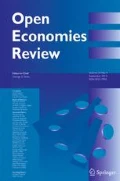Abstract
In this article, we study the determinants of cross-country variation in the level of international reserves over the period 1981–1995. Confirming intuition, trade openness is easily the most important variable. There is also some evidence that financial deepening is associated with an increase in the reserves ratio. Smaller and more volatile industrial countries hold larger reserves than their larger, less volatile counterparts. In addition, more indebted developing countries tend to have smaller reserve ratios. We view these results as establishing some interesting stylized facts that may be helpful in informing future theoretical modeling of reserves behavior.
Similar content being viewed by others
References
Bordo, Michael and Barry Eichengreen (1998) “The Rise and Fall of a Barbarous Relic: The Role of Gold.'' Mimeo, UC-Berkeley.
Cottarelli, Carlo and Carlo Giannini (1997) “Credibility without Rules? Monetary Frameworks in the Post-Bretton Woods Era.'' IMF Occasional Paper No. 154.
Eaton, Jonathan and Mark Gersowitz (1979) “LDC Participation in International Financial Markets, Debt and Reserves.''Journal of Development Economics 7:3–21.
Feldstein, Martin (1998) “A Self-Help Guide for Emerging Markets.'' Foreign Affairs 78:93–109.
Flanders, June (1971) “The Demand for International Reserves.'' Princeton Studies in International Finance No. 27.
Frankel, Jeffrey and David Romer (1999) “Does Trade Cause Growth?'' American Economic Review 89:379–399.
Frenkel, Jacob (1974) “The Demand for International Reserves by Developed and Less Developed Countries.'' Economica 41:14–24.
Goldfajn, Ilan and Rodrigo Valdes (1997) “Capital Flows and the Twin Crises: The Role of Liquidity.'' IMF Working Paper No. 97/87.
Ghosh, Atish, Ann-Marie Gulde, and Holger Wolf (1995) “Does the Nominal Exchange Rate Regime Matter?'' IMF Working Paper No. 95/121.
Grilli, Vittorio and Gian Maria Milesi-Ferretti (1995) “Economic Effects and Structural Determinants of Capital Controls.'' IMF Staff Papers 42:517–551.
Grubel, Herbert (1971) “The Demand for International Reserves: A Critical Review of the Literature.'' Journal of Economic Literature 9:1148–1166.
Kelly, Michael (1970) “The Demand for International Reserves.'' American Economic Review 59:655–667.
Kenen, Peter and Elinor Yudin (1965) “The Demand for International Reserves.'' Review of Economics and Statistics 47:242–250.
Landell-Mills, Joslin M. (1989) “The Demand for International Reserves and their Opportunity Cost.” IMF Staff Papers 36:708–732.
World Bank (1999) Global Development Finance CD-ROM.
Author information
Authors and Affiliations
Rights and permissions
About this article
Cite this article
Lane, P.R., Burke, D. The Empirics of Foreign Reserves. Open Economies Review 12, 423–434 (2001). https://doi.org/10.1023/A:1017939118781
Issue Date:
DOI: https://doi.org/10.1023/A:1017939118781




